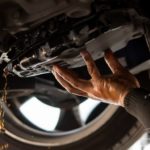
While the automatic transmission handles most of your gearbox’s gear changes, you still have some options. One of them is D3 gear. But what does D3 mean on a car, and when should it be used?
Table of Contents
What Does D3 Mean on A Car?
D3 employs the vehicle’s automatic transmission’s first three speeds, keeping it into third gear as the highest option. As a result, D3 delivers additional power in specific driving scenarios while giving each gear a wider RPM range.
The basic set of gears in most automatic autos includes P (Park), R (Reverse), and D (Drive) (Drive). The shifter must be set in D for everyday driving, and there is nothing more to consider. The gears shift automatically with the help of hydraulics when the car is in Drive.
Other options are available below the D gear on some automobiles. The D2, D3, and D4 options are visible. These display the car’s top gear position while traveling forward. The D3 gear, for example, is confined to third gear, but it can also use first and second.
Overdrive refers to the D (Drive) gear. Its goal is to save gas and increase the economy in everyday driving circumstances.
What Exactly Is the Distinction Between D3 and D?
When you select “D,” the automobile will automatically shift into the best gear for your current speed and acceleration.
The car may shift into higher gears in “D” mode to warm up the engine faster in cold weather.
When “D3” is selected, the automobile will automatically shift between the first three speeds, but not to a higher gear.
How Do I Shift to D3?
Typically, you’ll take your foot off the accelerator and shift to D3 on the shift lever. D3 mode is activated by a button on the shift lever in some vehicles.
It’s best not to shift and accelerate simultaneously, as this can harm the transmission.
Advantages of Driving in D3 Gear
1. Reduces brake wear
When the automobile is in D3, the engine automatically slows down. So you won’t need to use the brake pedal as much with this arrangement, especially when driving downhill.
While most brake pads are inexpensive to replace, there’s no reason to wear them out prematurely. Instead, consider shifting to D3 and allowing the engine to do some of the jobs if you’re heading down a steep road.
2. Throttle response increased
Lower ratios can assist you in getting the RPMs up higher for faster acceleration when pulling out into heavy traffic. When driving in the city, D3 is particularly advantageous because you don’t require high speeds and instead rely on quick throttle response.
Running the RPMs at the red line, on the other hand, could be harmful to the car. In this scenario, you might consider switching back to Drive to help the motor last longer.
3. Improved vehicle dynamics
You have better control over the vehicle when D3 mode is activated. For example, when driving in rainy conditions, you may sense it more when the vehicle is prone to slide. In addition, because D3 allows you to operate in lower gears, the automobile wheels will not spin as quickly, giving you more traction.
Furthermore, the engine brake feature mentioned earlier assists you in remaining secure when riding down steep inclines. The engine automatically keeps the car reined in to guarantee that extreme speeds do not become a problem.
What Is the Best Time to Utilize D3?
The D3 was not designed solely to provide drivers with a diverse driving experience. The D3 is helpful in a variety of traffic situations and can help you become safer on the road. When going downhill, D3 is one of the most useful features.
D3 can assist you in achieving engine braking when driving downhill. Engine braking is safe for your engine and will help you avoid moving too fast on a downhill route. It limits airflow, resulting in a high manifold vacuum, which causes your automobile to slow down.
Another situation where the D3 setting comes in handy is when driving uphill. Shifting to D3 keeps the transmission in the same gear or simply the third gear, which helps your car avoid slipping. Automatic gear changes can cause traction loss, especially at higher levels. Therefore using the D3 is the best way to go up. However, if the route is too steep, you can utilize the L gear to get through an uphill section.
D3 should be used on roads when a little extra speed is required. D2 and L, or low gear, on the other hand, should be used for low-speed runs or towing a car that has become stranded. D3 is typically used for city driving, whereas D2 or L is generally used for off-road driving or driving up a steep hill.
Hi there! I’m Naomi O’Colman. I’ve got years of experience working at an auto repair shop here in Texas under my belt. On top of that, ever since I was a kid I’ve been passionate about the auto industry. Since I’ve joined the team at automotivegearz.com I’ve been enthusiastically sharing my passion and insights with my readers. I’m dedicated to delivering high quality content and helping you stay up to date with the latest automotive trends and products out there!







